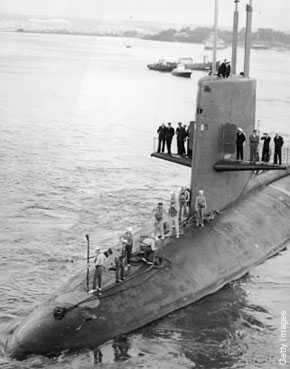USS
Growler rode high in the water at the Intrepid Museum on the West Side
of Manhattan Thursday, sparkling slate-gray in the midday sunshine though
dwarfed by the historic aircraft carrier tied up across Pier 86.
|
|
|

|
USS Scorpion:
Say a prayer for those lost in May
1968
|
|
|
|
Nothing new about that. Submarines don't
take up much room, as warships go, and they never have.
They do, however, more than pull their
weight.
Growler did.
Her return to the Intrepid Museum after
a two-year layup for refurbishment and repairs was marked by a moving,
if modest, ceremony at Pier 86 Thursday.
She was a hybrid, an evolutionary link
between the diesel-electric boats that demolished Japan's maritime forces
during World War II and the nuclear-powered ballistic-missile submarines
that played a decisive role in winning the Cold War.
Commissioned in 1958, Growler made nine
so-called deterrence patrols in the northern Pacific during some of the
most perilous periods of that decades-long conflict.
All Moscow really knew of Growler and
her sister ships back then was that one or another was always somewhere
close by, armed with nuclear-tipped missiles and thus posing an existential
threat to the Soviet Union itself.
The missile boats would be very, very
difficult to locate and destroy during a crisis. Best, then, that crises
not be allowed to get out of hand.
There were tense moments, of course,
but the fundamental plan -- deterrence -- worked.
The Cold War was won.
But, by then, Growler had long since
been laid up. Decommissioned in 1964, she languished at Puget Sound Naval
Shipyard in Bremerton, Wash., until the folks from the Intrepid Museum
-- the late Zachary Fisher chief among them -- brought her to the West
Side in 1988.
There she sits, a fascinating museum
in her own right -- but also a sterling memorial to those who served aboard
her back in the day, and to the Submarine Service itself.
And that's a thought worth holding for
a moment this Memorial Day weekend.
Growler wasn't the first naval submarine
to bear the name. Her predecessor, lost in the western Pacific to unknown
causes, had conducted 10 successful patrols against Japanese forces before
disappearing with 86 officers and men in November 1944.
That campaign began within days of Pearl
Harbor and arguably was one of the most successful in naval history.
"Only 1.6 percent of the US Navy's wartime
strength -- 16,000 men -- served in its submarines," writes the British
military historian Max Hastings in "Retribution," a 2008 account of the
last year of the Pacific war.
"Yet these accounted for 55 percent
of all of Japan's wartime shipping losses -- 1,300 vessels, including a
battleship, eight [aircraft] carriers and 11 cruisers [totaling] 6.1 million
tons," notes Hastings.
But, he continues, this success came
at a staggering personal cost to the submarine force.
"Twenty-two percent of all American
sailors who experienced submarine operations perished -- 375 officers and
3,131 enlisted men -- the highest loss rate of any branch of the wartime
US forces."
Still, writes Hastings, "There was never
a shortage of volunteers for the submarine service, with its extraordinary
pride and its buccaneering spirit."
Those who serve today, and the many
thousands of others whose own naval service was in submarines, will pause
for a moment this morning to recall that sacrifice, and to take quiet pride
in the spirit Hastings cites.
For they know that mortal danger didn't
pass with Japan's surrender in 1945. Three American warships have sunk
with loss of life since then, all submarines: USS
Cochino in August 1949; USS
Thresher in April 1963, and USS
Scorpion in May 1968.
And for all of the extraordinary effort
that goes into keeping submariners safe, they also know that catastrophe
is never farther away than a single failed valve packing, a burst pipe
fitting -- or an imprudent decision.
Memorial Day is an occasion for honoring
those who have died under arms in the service of America. And it is right
and proper that the nation's focus since 9/11 has been on the men and women
who have fought and died in Iraq, Afghanistan and elsewhere in the War
on Terror.
But honor also accrues to America's
fallen heroes from across the ages; thus is the return of USS Growler to
Pier 86 this weekend all the more appropriate.
Today is Memorial Day.
Say a quiet prayer for the fallen. |